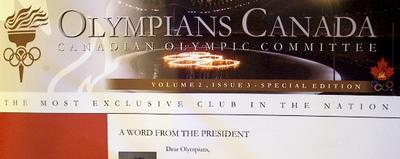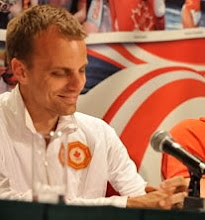Canadian Olympic champion Lori-Ann Muenzer has decided to take a year off from cycling competition.
Muenzer was the 2004 gold medalist in the match sprint, an accomplishment made more astonishing by the fact that she was 38 years old. All of the articles covering Muenzer's recent announcement attributed the decision to "funding issues," indicating that she just doesn't have enough money to cover the required competition schedule this year. She plans to continue training at home in Edmonton, and to make a decision on her future in twelve months.
Are you shocked? Did you think that an Olympic gold medal was a ticket to fame and fortune? Well then here, for your enlightenment, your athlete funding questions will be answered.
Q. Don't the federal government and the Canadian Olympic Committee give gold medalists a lot of financial support?
As an Olympic athlete you make $16,000 gross per year. I have no RSPs. I have no portfolio. I'm 39 years old and it is really time I started thinking about it. — Lori-Ann Muenzer
Every national team athlete in Canada receives a monthly living and training allowance from Sport Canada's Athlete Assistance Program. The current stipend is $1500 a month (more than three times what I ever got — not that I'm bitter), which amounts to $18,000 a year. Unless something has changed in the last eight years, that money is not subject to federal or provincial income tax. For an athlete of Muenzer's calibre, the COC's Excellence Fund probably kicks in a couple thousand more each year; less in the year after the Olympics, more in the year of the Olympics, but in that ballpark. I would guess that Muenzer is picking up about $20K annually, after taxes, from the government and the COC.
Q. Sure, but Muenzer is an Olympic champion. She gets more than everybody else, doesn't she?
No. Olympic champion Lori-Ann Muenzer doesn't get any more AAP money than any other national team athlete in Canada, and that includes a significant number of athletes who will never reach the Olympics. The AAP used to be graduated (A,B,C) based on international rankings, but Sport Canada did away with that system a few years ago.
Q. Is $20,000 enough money, or not?
In the quote above, Muenzer is trying to explain how difficult it is to live the life of an adult in Canada on $20K, never mind supporting your career as an elite athlete. Muenzer has a job (a "real" job, as we used to say), which helps her keep her head above water. Since her Olympic win she's also initiated a couple of projects, trying to turn her Olympic gold medal into a source of income. Note that she's not standing around shouting that she "deserves" more money; she's working hard to take care of her own future. Unfortunately, all that effort takes away from her ability to be a full-time athlete.
If Canada wants to produce and keep top-flight international athletes, then the government needs to provide a decent living allowance. That a Canadian cyclist won an Olympic gold medal while working another job is … well, it's something that just doesn't happen in the twenty-first century. If Canada wants to win Olympic medals like Australia does, then being an elite athlete should be a career, not a part-time job. I'm not talking about money as motivation — more on that topic later — I'm talking about money that allows an athlete to concentrate fully on their athletic performance.
Here's a useful point of reference: to bring in a yearly income of $18,000, you would have to have a full-time job that paid about $8.70 an hour. As I noted, the AAP is not subject to income tax or other deductions, so let's call it equivalent to $12 an hour. In 2003, about thirty percent of Canadian employees made less than $12 per hour of work. The median wage was $16 an hour. So sure, our elite athletes have enough to buy groceries, but no, they aren't getting a lot of money.
On the other hand, here's another point of reference: in 1996, an A-carded athlete (ranked top 4 in the world) made $7800 a year. So Sport Canada has already taken strong action on this issue.
Q. But Olympic athletes win big cash prizes for medals, don't they?
In Australia and several other countries now, they pay the podium. The going rate is $50,000 for an Olympic gold medal. I asked Muenzer what percentage of something like that she may have received. She held up her hand and made a circle - the universal sign for zero. — Terry Jones
There are no financial prizes awarded at the Olympics by the IOC. As far as I know, none of the International sport Federations give out prizes for medals won or records broken at the Olympics, either.
Neither the Canadian federal government nor the COC pays prize money to Canadian Olympic medalists, although this is standard practice in many other countries. As far as I am aware, none of Canada's NSOs or provincial sport organizations pay medal bonuses, either.
Q. So should Canada award prizes for Olympic medals?
Many people argue in favour of cash rewards. The quote above comes from Terry Jones of the Edmonton Sun, who wrote an article about the Muenzer situation that ran under the headline She's a Hero With Zero. Jones is essentially making the case that we (as a nation) owe these athletes a big prize, as a reward for all the hardship they went through on our behalf:
… once again a Canadian is having to settle for the journey and the moment as the payoff. After all those years of eating Kraft dinners, they don't give you steak. They give you all sorts of honours. But you can't eat fame and glory.
Putting the hyperbolic starvation metaphor aside, maybe we do owe Lori-Ann Muenzer something; I don't know. That sounds like a philosophical argument to me, and I'm not going to touch it. A more interesting question to me is: does it pay? Assuming that the goal is to win more Olympic medals, would offering financial prizes improve Canada's performance?
Q. OK, then. Would offering financial prizes for medals improve Canada's performance at the Olympics?
I don't see it. I guess there are two parts to the theory behind this practice. First, Canada's elite athletes are lacking motivation; and second, the chance to win a pile of money would provide that missing motivation. I don't even buy the first part. In my experience, Canadian athletes do not lack drive, or the desire to win; they're doing it for "the journey and the moment," and they're doing it as well as they can. If you don't believe me, try asking one of them if they could possibly be working harder towards their goals.
Again, this is not to say that Canadian athletes couldn't use more money; in many cases their training and preparation are hindered by a lack of funding. But providing prize money doesn't solve those problems until it's too late. Athletes need more support when they're preparing for the Olympics. That's a much more effective way to improve performance, in my opinion.
Q. What about government money that's given to NSOs?
[Steve Lacell, Chief Operating Officer of the Canadian Cycling Association] was disappointed by Muenzer's decision. The association has been lobbying Sport Canada and the [sic] corporate Canada for extra funding for elite athletes. He said there is some hope there will be increased funding in the spring federal budget … Lacelle said he hopes Muenzer will reconsider. "It is a blow. She is a gold medallist," he said from Ottawa. "We are working at getting additional funding so we can prevent these situations from happening."
In addition to government money that goes directly into her pocket, Muenzer benefits from public funds through her national sport organization (NSO). I don't have any inside knowledge about the workings of the Canadian Cycling Association; some of what I'm about to say will assume that the CCA is well-run, and is doing its best to produce world-class Canadian cyclists. I may be wrong on both counts, but I have not seen Muenzer being critical of the CCA, so far.
Funding for NSOs is allocated in different categories. The part that we are interested in here is the high-performance budget. Based on my experience as a volunteer at another Canadian NSO, I suspect that the CCA spends most of its high performance budget on coaching, equipment, and travel. These are exactly the expenses that Muenzer is claiming she can't meet herself, so why can't the CCA help her out?
Let's look at the numbers. The CCA is one of the "have" NSOs in Canada. Cycling was allocated $435,000 for its high-performance program in 2005, seventh most among all NSOs. The CCA is responsible for all three Olympic cycling disciplines (road, track, and mountain bike). Altogether there are 38 carded athletes (national team supported through AAP) in cycling, which gives you a rough idea that the CCA can spend about $11,000 per carded athlete per year. (The CCA undoubtedly has some private-sector income as well, but this is a good first approximation.) If you divide the high-performance money equally between all 150 athletes in the "national team pool" instead, then you've only got about $3000 per athlete.
In a sport like cycling, where all of the serious competition is in Europe or Australia, and where equipment has a huge impact on performance, that kind of money doesn't go very far.
Q. But couldn't they have gone out of their way to provide more in Muenzer's case? She is an Olympic champion, after all.
Muenzer probably does get more than an equal share of the CCA's support, since she's one of their best athletes. And yes, the CCA probably could do more if they chose to. But would that be the wisest decision? The CCA's high-performance funding is determined, in large part, by the performance of their national team each year. So if you've got a limited amount of money, and if your future funding depends on the future performance of your national team, do you spend extra to make your 39-year-old Olympic champion happy? After all Muenzer, who was eliminated in the quarter finals at the 2005 world championships, is unlikely to ever reproduce her 2004 performance. For all their nice words, it's not really in the CCA's best interests to make sacrifices for their gold medalist.
Basically what it comes down to is that Canadian NSOs are underfunded. If the defending Olympic champion and her coach decide that they need to spend four months in Europe racing, then their NSO should be able to afford it, and not at the expense of the rest of the high performance program. That's not the reality in Canada today, though.
Q. Wait a minute. If NSO funding depends on athlete performance, then doesn't a big chunk of the 2005 money belong to Muenzer?
It's definitely true that the CCA's high performance allocation was partly due to Muenzer's Olympic gold medal; and now it sounds like Steve Lacell might use her financial difficulties to lobby for even more government support! I suppose you could argue that Muenzer deserves to reap the lion's share of the rewards, but I think that this argument ignores what's come before. It is likely that the CCA provided a lot of financial support to Muenzer before she became Olympic champion, using money that was "earned" by athletes like Curt Harnett, Alison Sydor, and Steve Bauer.
Q. What about private sponsorship? Can't Olympic champions get rich from endorsements?
You think that when you win a gold medal that your world is going to change, that you are going to have to open a couple of bank accounts. — Lori-Ann Muenzer
Canada had only three gold medal winners in 2004: Muenzer, gymnast Kyle Shewfelt, and flatwater kayaker Adam van Koeverden. Although none of these athletes is a household name — and none of them are getting rich — van Koeverden and (especially) Shewfelt compete in more popular sports than Muenzer. In addition, van Koeverden and Shewfelt are both 23 years old, and have the potential to be at the top of their respective sports for some time to come. Perhaps that is part of the reason that Shewfelt and van Koeverden have both signed with IMG, while Muenzer is left to promote herself, and has no sponsors.
But is there really so little interest in Olympic champions in Canada that Muenzer can't find anything? Adam Nelson, a shotputter from the US — not an Olympic champion — found somebody who was willing to pay him $12,000 for a one-month contract, and there's no shortage of Olympic medalists in the USA. Joanna Stone, a javelin thrower from Australia — also not an Olympic champion, and also in a country where they are relatively plentiful — earned $12,000 in sponsorships in 1999. I know that this isn't a conclusive sample, but there is some evidence that athlete sponsorships are much more widespread in other countries than they are in Canada.
Q. Why is it so difficult in Canada, then?
The standard explanation goes like this: corporations don't put money into amateur sport sponsorships because they don't pay. It isn't an effective marketing strategy because Canadians (their customers) don't care enough about sports, so corporations are better off spending their money on other types of advertising. If Canadians paid more attention to amateur sports, then corporate money would follow quickly after.
I think that there is some truth in this argument, in the sense that the amount of money directed into athletic sponsorships depends strongly on the level of public interest in amateur sports. However, I have a hard time believing that athletic sponsorships don't pay, because the price is so low. I don't know what kind of money van Koeverden or Shewfelt are making from endorsements, but how much do you think it would take to get Lori-Ann Muenzer's interest? The amount is probably measured in thousands of dollars, not tens of thousands. In the world of corporate advertising, that's peanuts.
The final point I would make about this argument is that it falsely absolves the corporations of any responsibility. It's true that Canadians don't care as much about amateur sport as Australians, but we shouldn't forget that some of those uncaring Canadians run Canadian corporations. I would bet that athletic sponsorships are not the most efficient way to advertise in Australia either; the fact that they are more common there is due to the fact that consumers and corporate executives believe that supporting amateur sport is a worthy cause, in a way that Canadians don't.





